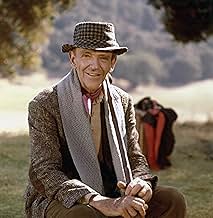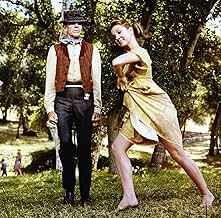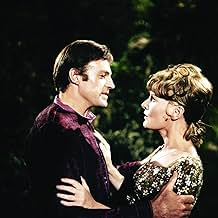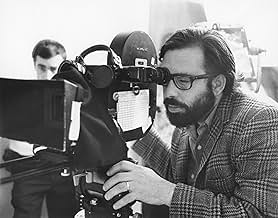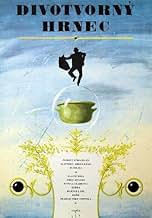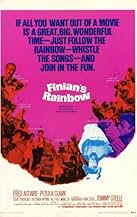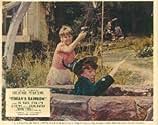CALIFICACIÓN DE IMDb
6.1/10
4.3 k
TU CALIFICACIÓN
Un inmigrante irlandés y su hija se trasladan al sur de Estados Unidos con una mágica pieza de oro que cambiará la vida de la gente, incluidos un granjero en apuros y ciudadanos afroamerican... Leer todoUn inmigrante irlandés y su hija se trasladan al sur de Estados Unidos con una mágica pieza de oro que cambiará la vida de la gente, incluidos un granjero en apuros y ciudadanos afroamericanos amenazados por un político intolerante.Un inmigrante irlandés y su hija se trasladan al sur de Estados Unidos con una mágica pieza de oro que cambiará la vida de la gente, incluidos un granjero en apuros y ciudadanos afroamericanos amenazados por un político intolerante.
- Nominado a 2 premios Óscar
- 1 premio ganado y 9 nominaciones en total
Brenda Arnau
- Sharecropper 'Necessity'
- (sin créditos)
Charles Carter
- Sharecropper
- (sin créditos)
Sterling Clark
- Sharecropper
- (sin créditos)
Robert Cleaves
- Geologist
- (sin créditos)
Robert Cole
- Sharecropper
- (sin créditos)
Willie Covan
- Sharecropper
- (sin créditos)
Evelyn Dutton
- Sharecropper
- (sin créditos)
Argumento
¿Sabías que…?
- TriviaMany, including Fred Astaire, blamed director Francis Ford Coppola for cutting off Astaire's feet during filming of his dancing scenes, but it was Warner Bros. who decided, after the filming had been completed in 35mm, to convert the film to the wider 70mm and promote it as a "reserved-ticket roadshow attraction." This was achieved by cropping off the tops and bottoms of the film frame, including some shots of Astaire's footwork.
- ErroresIn the song "Old Devil Moon" as Woody and Sharon dance through the stream, Woody has bare feet and his hands are in Sharon's. In the next shot, he has his shoes on, and it even looks as if his trousers are dry.
- Créditos curiososintroducing Barbara Hancock as "Susan the Silent"
- Versiones alternativasFilmed in 35mm, Warners decided afterwards to promote it as a "reserved-ticket roadshow attraction" and converted it to 70mm, creating a wider-screen aspect ratio by cropping away the tops and bottoms of the images, and cropping away Fred Astaire's feet during some of his dance scenes. Restored versions show the original aspect ratio.
- ConexionesEdited into The Kid Stays in the Picture (2002)
- Bandas sonorasLook To The Rainbow / How Are Things In Glocca Morra?
(1946) (uncredited)
(Main Title)
Played during the opening credits
Lyrics by E.Y. Harburg
Music by Burton Lane
Sung by Petula Clark ("Rainbow") and played by the Warner Bros.
Orchestra ("Glocca Morra") conducted by Ray Heindorf
Opinión destacada
Finian (Fred Astaire) and his daughter (Petula Clark) arrive in the fictional Southern American state of Missitucky. There, Finian encounters several problems--including a leprechaun who wants his pot of gold back, a racist senator and the need to marry off his daughter. How all these are worked out are something for you to discover if you decide to see the film.
"Finian's Rainbow" was a very successful play back in 1947. However, because it directly addressed racial prejudice, studios passed on making a film out of it. Efforts to have the play 'cleaned up' to please a wider (in other words, more prejudiced) audience were in vain, as the playwright refused (justifiably) to sanitize the film. However, by 1968, its themes of racial harmony and bigotry were much more acceptable and current--and so the film was finally made. In this sense, the film was very timely. HOWEVER, when it came to the music, by 1960s standards it was VERY corny. In particular, the songs sung by the leprechaun were amazingly bad--with some horrible lyrics. But, the bad lyrics weren't confined to his songs but occasionally popped up among other cast members (such as Clark who sang a line that went 'Zsa-Zsa Gabor-ah' and later when Astaire sung about 'dames'). Because of this, a bit of trimming would have greatly improved the film--making it far less dated and silly. Plus, the bad moments really detract from its central message of racial harmony--a laudable theme that occasionally got lost among the silliness. It also meant a few too many songs--a problem that can hurt any musical. Overall, this can truly be called a mixed bag. While it stars Fred Astaire and I LOVE him in films, this just isn't all that great a film. A time-passer--and that's about all--even though it has some nice moments.
By the way, for years Fred Astaire was NEVER shown dancing in films unless ALL of him was shown. He felt it detracted from the dancing if he wasn't shown from head to toe. Well, he did NOT negotiate such a contract with the folks making "Finian's Rainbow", as he DOES dance and you don't see him from head to toe in songs such as "The Idle Rich". Perhaps this was due to his age and his slowing down a bit--which might explain why this was his last musical.
"Finian's Rainbow" was a very successful play back in 1947. However, because it directly addressed racial prejudice, studios passed on making a film out of it. Efforts to have the play 'cleaned up' to please a wider (in other words, more prejudiced) audience were in vain, as the playwright refused (justifiably) to sanitize the film. However, by 1968, its themes of racial harmony and bigotry were much more acceptable and current--and so the film was finally made. In this sense, the film was very timely. HOWEVER, when it came to the music, by 1960s standards it was VERY corny. In particular, the songs sung by the leprechaun were amazingly bad--with some horrible lyrics. But, the bad lyrics weren't confined to his songs but occasionally popped up among other cast members (such as Clark who sang a line that went 'Zsa-Zsa Gabor-ah' and later when Astaire sung about 'dames'). Because of this, a bit of trimming would have greatly improved the film--making it far less dated and silly. Plus, the bad moments really detract from its central message of racial harmony--a laudable theme that occasionally got lost among the silliness. It also meant a few too many songs--a problem that can hurt any musical. Overall, this can truly be called a mixed bag. While it stars Fred Astaire and I LOVE him in films, this just isn't all that great a film. A time-passer--and that's about all--even though it has some nice moments.
By the way, for years Fred Astaire was NEVER shown dancing in films unless ALL of him was shown. He felt it detracted from the dancing if he wasn't shown from head to toe. Well, he did NOT negotiate such a contract with the folks making "Finian's Rainbow", as he DOES dance and you don't see him from head to toe in songs such as "The Idle Rich". Perhaps this was due to his age and his slowing down a bit--which might explain why this was his last musical.
- planktonrules
- 8 ene 2013
- Enlace permanente
Selecciones populares
Inicia sesión para calificar y agrega a la lista de videos para obtener recomendaciones personalizadas
- How long is Finian's Rainbow?Con tecnología de Alexa
Detalles
Taquilla
- Presupuesto
- USD 3,500,000 (estimado)
- Tiempo de ejecución2 horas 21 minutos
- Relación de aspecto
- 2.39 : 1
Contribuir a esta página
Sugiere una edición o agrega el contenido que falta

Principales brechas de datos
By what name was El camino del arco iris (1968) officially released in India in English?
Responda

